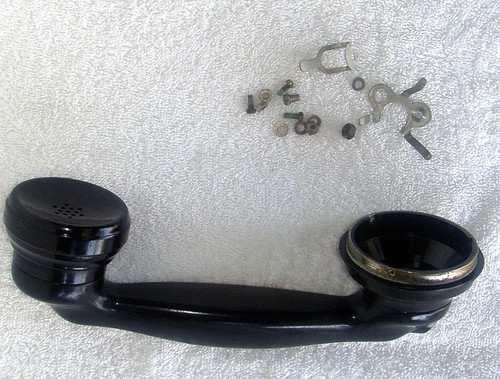Another telephone spare part has emerged from the 'fog of time' - my storage units ...
Bakelite based, this handset was part of a manual 'fire station' telephone system installed at a factory. The 'fire station' worked like this ...
You see a FIRE!
Race to the 'fire telephone station', pickup handset (if not burning) and wait for the local fire station to 'pickup' - no numbers to dial, just wait for someone to respond at the fire station.
Provide details of the fire then run to safety ...
These bakelite phones & handsets were ideal in those situations as bakelite does not melt under high temperatures although of course it could still burn your hand! Bakelite is far more temperature resistance than most plastics, which tend to turn into little 'puddles of colour' in a fire.
The previous life of this handset and the associated phone, gave rise to the painting of the phone a bright Red (you could say Fire Engine Red). This paintwork looks a bit tatty these days but never judge a book (or phone handset) by it's "cover" - underneath that patchy Red paintwork is a nice Black bakelite handset, undamaged although obviously parts are missing ...
SIEMENS BROTHERS (London) - Telephone apparatus handset
Circa 1930's onwards - this is based on the patents indicated on the handset and applied for, relating to telephone instruments in the 1930's
Siemens Brothers UK were formed in the late 1800's by William Siemens, origins of the family being German. Some company ownership changes occurred during WWI as the existing owners were considered as "enemy aliens" at the time.
Stamped into the central area on the 'inside' of the handset is ...
PAT. 328926
SIEMENS
Brothers & Co. Ltd
LONDON
PAT SA. 9/30
Material: Bakelite (I have positively confirmed the body as being all bakelite, a quick rub test shows up the tell-tale Brown/Yellow residue and that distinctive smell of formaldehyde)
Bakelite was the predecessor to "modern plastics" and used extensively pre-1960's
The body has been completely painted (looks to have been sprayed) in a bright Red colour which, after around 80+ years is beginning to come off in flakes - old people will know about this! I experience it every day ...
I test "rubbed' the Red paint and it will easily be removed, just using iso alcohol was enough to start removing the paint - cleaning this back to the beautiful Black underneath should not be a difficult task.
The are NO receiver or transmitter caps (obviously) - this handset is offered 'as-is' for spare parts only
The receiver twin pole assembly remains fitted and has been tested but you will hear no sound until the flat round plate is found and placed on the top, just above the poles.
The transmitter capsule (carbon granule based) is missing entirely.
Wiring between the receiver and the cord exit hole down at the transmitter end remains intact and has also been tested.
There is of course no handset cord either.
I am offering exactly as pictured, no "hidden extras"
Most likely that this incomplete handset is only of interest to a "bakelite collector" or someone who would like to restore their old bakelite telephone instrument.
TESTING:
There is really only one component to test, the partial receiver section. The DC resistance of the coils is 80 Ohm total (this is fine) and I checked the wiring through to the 'far end' at the transmitter area (before the wires exit the handset via a cord) and all is good here too.
COSMETIC CONDITION:
On the surface, rough-as but clean away that Red paint and underneath the bakelite looks to be in very good condition with no cracks or chips that I could see.
A bit of metalwork around the transmitter area needs a cleanup but again, this is no big deal.
I have now packed this Siemens Brothers handset away into a sealed clear plastic packet awaiting a new purpose in life or to give life to another similar handset as parts.

















